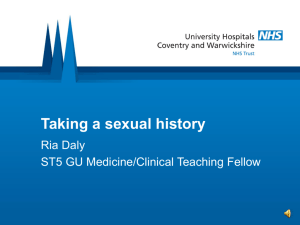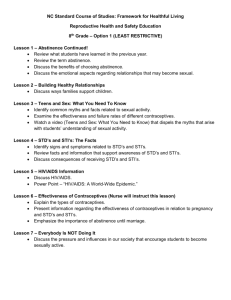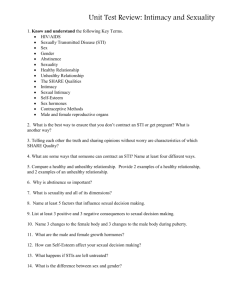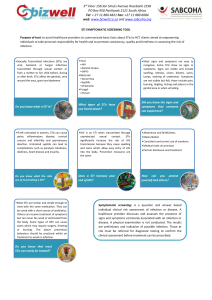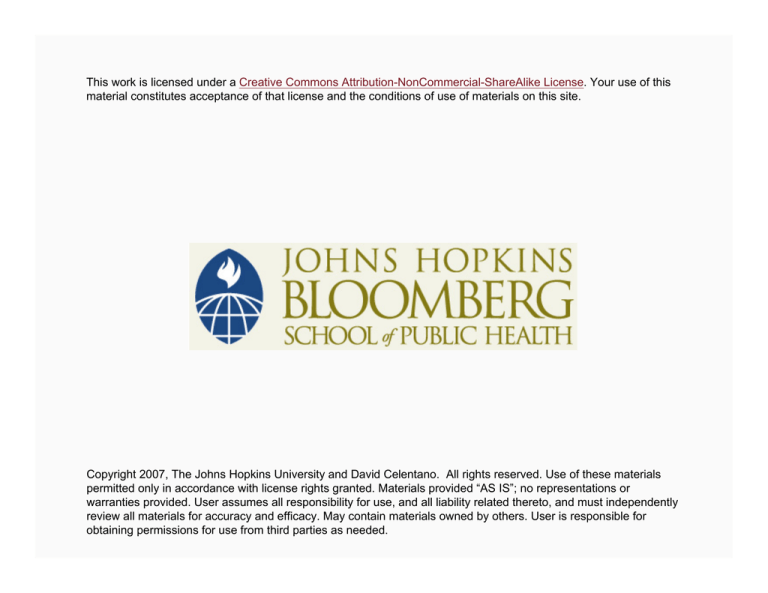
This work is licensed under a Creative Commons Attribution-NonCommercial-ShareAlike License. Your use of this
material constitutes acceptance of that license and the conditions of use of materials on this site.
Copyright 2007, The Johns Hopkins University and David Celentano. All rights reserved. Use of these materials
permitted only in accordance with license rights granted. Materials provided “AS IS”; no representations or
warranties provided. User assumes all responsibility for use, and all liability related thereto, and must independently
review all materials for accuracy and efficacy. May contain materials owned by others. User is responsible for
obtaining permissions for use from third parties as needed.
Behavioral Intervention
David D. Celentano, SHPH
Objectives
To discuss contemporary perspectives on sexual
behavior and STI/HIV risks
To describe sexual mixing patterns as a causal factor in
STI/HIV transmission
To summarize prevention strategies that offer promise
3
Importance of Preventing and Controlling STIs
International health objective
High rates of complications and adverse health
outcomes
High human and economic costs
STIs facilitate the transmission
of HIV
Substance use may influence both HIV and STI
acquisition
4
Section A
Epidemiology by Age and Race
Chlamydia—Age- and Sex-Specific Rates
Chlamydia—age- and sex-specific rates: United States,
2002
Men
3,000
Rate (per 100,000 population)
2,400
1,800
1,200
600
0
10.2
408.4
691.5
331.6
163.2
82.1
46.0
19.7
6.4
2.1
130.4
Age
10-14
15-19
20-24
25-29
30-34
35-39
40-44
45-54
55-64
65+
Total
0
Women
600
1,200
1,800
2,400
3,000
142.1
2,619.1
2,570.1
875.8
328.7
123.9
55.5
20.8
5.6
2.5
456.5
6
Gonorrhea—Age- and Sex-Specific Rates
Gonorrhea—age- and sex-specific rates: United States,
2002
Men
750
Rate (per 100,000 population)
600
450
300
150
0
7.4
287.9
538.1
320.4
199.2
131.4
92.1
48.1
17.3
4.4
124.5
Age
10-14
15-19
20-24
25-29
30-34
35-39
40-44
45-54
55-64
65+
Total
0
Women
150
300
450
600
750
46.6
675.6
650.3
251.4
113.1
57.4
31.3
10.6
2.1
0.8
125.5
7
Chlamydia, Gonorrhea, and Syphilis Rates in Baltimore
Chlamydia, gonorrhea, and primary and secondary
Chlamydia,
and P&S Syphilis1994–2002
Rates in Baltimore, 1994 to 2002
syphilis Gonorrhea,
rates in Baltimore,
1200
Rate (per 100,000)
1000
800
600
400
200
0
1995
1996
1997
1998
Year
1999
CT
GC
Primary and secondary syphilis
2000
2001
2002
8
Chlamydia Rates by Race and Gender
Chlamydia Rates by Race and Gender,
Baltimore City 1999
2000
Males
Females
Total
1897
1800
Rate per 100,000
1600
1400
1143
1200
Source: 1999 Baltimore City Health Department, STD Surveillance Program
1000
800
600
400
434
281
261
142
200
25
86
128
0
African American
Caucasian
Other/Unknown
Race
Source: 1999 Baltimore City Health Department, STD Surveillance Program
9
Gonorrhea Rates by Race and Gender
Gonorrhea Rates by Race and Gender,
Baltimore City 1999
1800
Males
Females
Total
1647
1600
1350
Rate per 100,000
1400
1200
1096
1000
800
600
400
273
200
65
76
193 233
71
0
African American
Caucasian
Other/Unknown
Race
Source: 1999 Baltimore City Health Department, STD Surveillance Program
10
Section B
Role of Social Factors
Social Factors Affecting the Spread of STIs
Lack of gender equity
Poverty and transactional sex
Disruptions to traditional family life
Inadequate health services
Legal, cultural, and religious barriers to condom
promotion and use
12
Other STIs increase risk of HIV infection
Presence of other STIs increases the risk of HIV
acquisition
− Ulcerative STIs
X 10–300 times per exposure
− Non-ulcerative STIs
X 3–10 times per exposure
13
Risks for STIs in Adolescents and Young Adults
Biologic factors may increase susceptibility for female
adolescents
− Cervical ectopy
− Greater risk of infection at 1st exposure
− Hormonal changes
Social factors
− Limited access to services
− Nonconsensual sex
Continued
14
Risks for STIs in Adolescents and Young Adults
STI sexual risk behaviors among 15–24 year olds may
be more prevalent (vs. adults)
− High number of sex partners
− Alcohol and drug use
− Inconsistent and incorrect condom use
− Lack of knowledge or negotiation skills
− Invulnerability and willingness to take risks
15
Limitations of Known Epidemiologic Risk Factors
Lack of explanatory power of identified individual
sexual behaviors to explain STI acquisition
− Most OR/RR on the order of < 3.0
− Most risky people do not acquire disease
− All known risks account for < 1/3 of disease
16
Reproductive Rate
Simple but useful equation
Ro = ß c D
Reproductive rate
Probability of transmission
Probability of transmission
Number of sexual contacts
Number
of sexual contacts
Duration of infectiousness
Duration of infectiousness
T Notes Available
17
Additional Social Risk Factors
Relationships between social and sexual networks
18
Additional Social Risk Factors
Relationships between social and sexual networks
Structure of sexual networks
− Concurrency
− Serial sexual partners
− Mixing patterns
19
Additional Social Risk Factors
Relationships between social and sexual networks
Structure of sexual networks
− Concurrency
− Serial sexual partners
− Mixing patterns
Core group and core transmitters
Frequency and type of substance use/abuse
20
STD Control: Public Health Strategies
Targeting core transmitters for prevention and
treatment services
Changing social norms
− Safer sexual behaviors
− Condom use
− Altering substance use/sex equation
21
Public Health Strategies: Core Transmitters
Core group
People who have sex with both groups
General population
22
Public Health Strategies: Containing the Epidemic
Targeting core transmitters—most effective STI
prevention
− Target population (Kenya)
500 sex workers (80% HIV +)
with four clients per day
10,200 HIV infections
prevented
500 low-income men (10% HIV+)
with four partners per year
88 averted infections
23
Geographic Distribution of STDs
STIs are not equally distributed across neighborhoods
Studies in Colorado Springs, Dade County, North
Carolina, Miami, San Francisco, and Baltimore show
similar findings
24
Gonorrhea Rate Categories by Census Block Group
Gonorrhea rate categories by census block group in
Baltimore, Maryland, 1995–1998
= GC 5,000-1,039 per 100,000
= GC 1,038–167 per 100,000
= GC 166-0 per 100,000
25
Association Between Core Neighborhood and Core Transmitter
Association between core neighborhood and core
transmitter
− Core neighborhoods—geographic units with
high prevalence of STIs
− Core transmitters—individuals in core
neighborhoods who engage in “risky” social
behaviors and experience a large proportion of
diagnosed STDs
26
Core Groups and Transmission Dynamics
Core groups are critical to maintaining high rates of
gonorrhea in community-based models of STI
transmission
− Cores are characterized by high transmission
density
27
Links Between Neighborhood Characteristics and STIs
Studies have consistently found higher rates of STIs in
neighborhoods with the following characteristics:
− Poverty
− Social disadvantage
− Segregation
− Drug abuse
Few studies have linked community-level
characteristics to individuals
28
Section C
Sexual Mixing (Partner Selection)
Sexual Mixing
The extent of sexual contact within and among
definable segments of the population
Segments of the population can be defined by factors
such as
− Age
− Race/ethnicity
− Sex
− Geography
− Drug use patterns
30
Mixing Patterns
Assortative
Boily STD 2000:27(10);560-71
Random
Disassortative
31
Sex Partner Selection and Mixing Patterns
Laumann (1998)
− Higher STI rates in African Americans is partly due
to patterns of sexual networks
− STIs remain endemic because partner selections
are more assortative by race/ethnicity
− Partner selection is more disassortative by
demographic characteristics among AfricanAmericans than other groups
32
Sex Partner Selection and Mixing Patterns
Aral (1996 )
− STI morbidity concentrations create potential
partner pools with high-risk behaviors and high
rates of sexually transmitted infections
− These geographic and social contexts create a
higher probability of exposure to infection for each
sex act
33
Evidence for Sex Partner Selection and Mixing Patterns
Ellen (1998)
− African American adolescents are more likely to
practice assortative mixing on race/ethnicity vs.
other adolescents
Zenilman & Glass (1999)
− In adult STD patients, core neighborhood residents
are more likely to have sex partners from core
neighborhoods
34
Evidence for Sex Partner Selection and Mixing Patterns
Celentano et al. (2005)
− Young African American MSM have sex partners
from core neighborhoods who are exclusively
African American
X HIV prevalence is ~25%, as compared to 1%
among whites (holds for both Baltimore and
New York City)
35
Sexual Behavior Intervention Targets
Individual
Group
Community
36
Modality of Interventions
Behavior change
Treatment
Vaccine
Structural change
Microbicide
Surgical change
37
Intervention Outcomes
Acquisition
Transmission
Complications
38
Section D
Sexual Behavior Interventions: What Works?
Behavior Change for STI Prevention
What do we know about behavior change for STI
prevention?
− We know the targets
X Abstinence (drugs/sex)
X Motivating risk reduction
X Establishing safer behavior
40
What Works?
What works?
41
What Works: Increasing Access
STI services and case ascertainment
Partner referral and outreach
Primary medical care
Timely prenatal care
Counseling and testing
42
What Works: Counseling and Educational Strategies
Individual risk reduction counseling
Small group interventions
Couples counseling
43
What Works: Institution-Based Strategies
Schools
Prisons
Bars
Military
44
What Works: Media-Based Strategies
Condom social marketing
Behavior change communications
Promoting popular culture
45
What Works: Community-Level Strategies
Social norm change
Promotion of monogamy
Needle disinfection and needle exchange
46
What Works: Medical Strategies
STD diagnosis and management
Drug treatment
ART to prevent perinatal transmission
ART to prevent sexual transmission
47
Challenges in HIV and STI Prevention
Maintenance of behavior change
Targeting hard to reach populations
Prevention in the era of HAART, PEP, PREP, and
“waiting for a vaccine”
48
Challenges in HIV and STI Prevention
Maintenance of behavior change
Targeting hard to reach populations
Prevention in the era of HAART, PEP, PREP, and
“waiting for a vaccine”
Young people, especially adolescent girls
Alcohol use and HIV transmission
STD clinic attendees differ from other risky
adolescents/young adults
Advocacy for changing health policy
49
Section E
The International Voluntary Counseling and Testing
Study
Design of the VCT Efficacy Study
Multicenter randomized trial: 1995–1997
Three sites: Kenya, Tanzania, and Trinidad
Randomized to receive (VCT) or health information(HI)
Traced and interviewed at six and twelve months
Cross-over at six months so that the original HI group
now had access to VCT
51
VCT Efficacy Study: Sample Size
3,120 individuals
− 1,563 to VCT; 1,557 to HI
− 1,534 men; 1,586 women
− 82% retained at first follow-up
− 70% retained at second follow-up
586 couples
− 85% retained at first follow-up
− 76% retained at second follow-up
52
Men and Women Assigned to VCT
Men and women assigned to VCT reduced
unprotected intercourse with non-primary partners,
but HI reduced after they received VCT
35
P<.01
P<.009
30
25
20
Baseline
Baseline
1stfollow-up
Fup
1st
2nd
2ndfollow-up
Fup
15
10
5
0
Men
VCT
Women
VCT
53
Couples Assigned to VCT at Baseline
Couples assigned to VCT at baseline reduced
unprotected intercourse with enrolment partners,
but HI reduced as much after they received VCT
90
80
70
60
P<.02
50
40
30
20
10
0
VCT
HI
Baseline
Fup 2nd
2ndfollow-up
Fup
Baseline 1st1st
follow-up
54
HIV VCT Is Cost-Effective
Delivery
− $26.65 in Kenya
− $28.93 in Tanzania
Averted HIV infections:
− 1100 in Kenya
− >800 in Tanzania
$250,000 to $300,000 for 10,000 clients
Continued
55
HIV VCT Is Cost-Effective
DALY
− $12.77 in Kenya
− $17.78 in Tanzania
Childhood immunization
− $12 to $17 per DALY
Increased prevalence to 45%
− $8 to $12 per DALY
56
Conclusions
People wanted VCT, did not have access to it
We have a lot of effective tools in our kit
We know how to apply these tools
Currently learning from the field how to target and
tailor our interventions
Political will may be more important than “science” in
this century
We need to overcome negativism!
57


